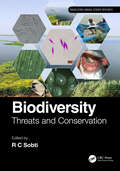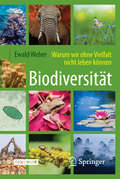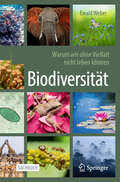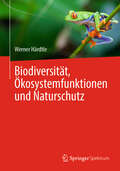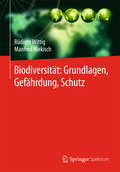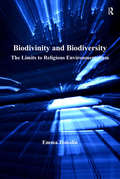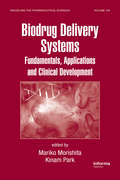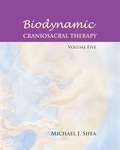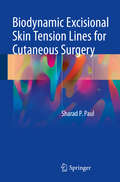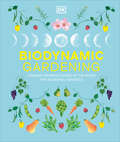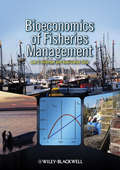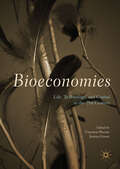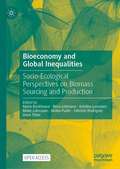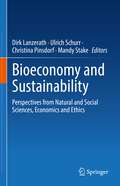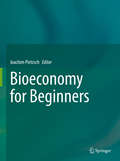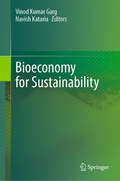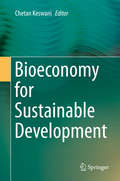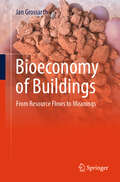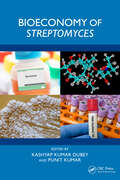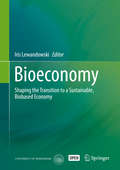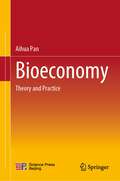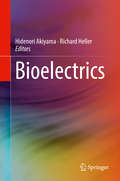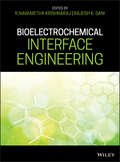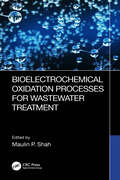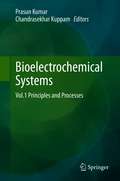- Table View
- List View
Biodiversity: Threats and Conservation (Translating Animal Science Research)
by Rc SobtiThe term "biodiversity" or "biological diversity" describes the variety of living beings on Earth encompassing microorganisms, plants, animals, and ecosystems, such as coral reefs, forests, and deserts. In fact, it also represents a wealth of biological resources available to us. Today, instead of exploring and preserving its unmapped biodiversity, mankind has gone away from mother nature, conquering the domain through relentless exploitation. This has resulted in an ecological imbalance and thereby has posed serious threat to biodiversity. Declining biodiversity is, therefore, a concern for countless reasons. Biodiversity’s wealth of genetic information can be conserved by storing biological material from endangered species. Cell lines, gametes, and embryos are preserved so that in case a species becomes extinct or there is a need to increase the population of the species, then cloning and artificial reproductive techniques can be used to revive and reproduce the said species. The present volume discusses the biodiversity of specific animal groups, such as cnidarians and fish, as well as potential risks to and methods for conserving some of them. The following important aspects are addressed: 1. The importance of biodiversity in maintaining ecosystem balance for sustainability 2. The emerging role of biodiversity as a source of important materials, pharmaceuticals, food, and so on as such or through genetic manipulation to meet the contemporary and future challenges 3. The impact of environment degradation on biodiversity and conservation in a changing environment 4. Conventional and emerging biotechnological techniques to conserve biodiversity The book is intended for academics, scientists, and naturalists working in the fields of biology, biochemistry, biophysics, and biomedical sciences.
Biodiversität - Warum wir ohne Vielfalt nicht leben können
by Ewald WeberEine Einladung in die Biologie der Vielfalt Dieses Buch berichtet über ein ebenso spannendes wie aktuelles Thema an der Schnittstelle zwischen naturwissenschaftlicher Grundlagenforschung und globaler gesellschaftlicher Herausforderung: die Biodiversität. Drei Ebenen kommen hier zusammen: die Vielfalt der Arten in einem Lebensraum, die Vielfalt der Ökosysteme und Lebensräume selbst und die Vielfalt der Gene in den Lebewesen. Der Autor, Biologe und selbst in der Biodiversitätsforschung tätig, nimmt Sie mit auf eine aufregende Entdeckungsreise durch diese mannigfach vernetzte Welt. In leicht verständlicher Sprache und mit vielen anschaulichen Beispielen erklärt er Zusammenhänge und Hintergründe. Wie ist Biodiversität eigentlich definiert, und mit welchen Techniken wird sie erfasst? Wie ist die immense Artenvielfalt auf der Erde entstanden, und wie entwickelt sie sich weiter? Welchen Nutzen hat die Biodiversität auf den verschiedenen Ebenen? In welchem Maße ist die Vielfalt der Arten und Lebensräume heute bedroht, und wie kann man diesem Trend entgegenwirken? Solche und ähnliche Fragen beantwortet dieses Buch, in dessen breitem Themenbogen sich die Vielfalt seines Gegenstands wiederspiegelt. Tauchen Sie ein in die faszinierende Welt der Biodiversität! Der AutorEwald Weber ist Biologe und Sachbuchautor. Er lehrt und forscht an der Universität Potsdam mit Schwerpunkt Biodiversität. Sein Anliegen als Autor ist das Vermitteln von wissenschaftlichen Zusammenhängen und von Naturgeschichte im weitesten Sinn.
Biodiversität - Warum wir ohne Vielfalt nicht leben können
by Ewald WeberDieses Buch berichtet über ein ebenso spannendes wie aktuelles Thema an der Schnittstelle zwischen naturwissenschaftlicher Grundlagenforschung und globaler gesellschaftlicher Herausforderung: die Biodiversität. Drei Ebenen kommen hier zusammen: die Vielfalt der Arten in einem Lebensraum, die Vielfalt der Ökosysteme und Lebensräume selbst und die Vielfalt der Gene in den Lebewesen. Der Autor ist Biologe und war selbst in der Biodiversitätsforschung tätig. Er nimmt Sie mit auf eine aufregende Entdeckungsreise durch diese mannigfach vernetzte Welt. In leicht verständlicher Sprache und mit vielen anschaulichen Beispielen erklärt er komplexe Zusammenhänge und Hintergründe. Wie ist Biodiversität definiert, und mit welchen Techniken wird sie erfasst? Wie ist die immense Artenvielfalt auf der Erde entstanden, und wie entwickelt sie sich weiter? Welchen Nutzen hat die Biodiversität auf den verschiedenen Ebenen? In welchem Maße ist die Vielfalt der Arten und Lebensräume heute bedroht, und wie kann man diesem Trend entgegenwirken? Solche und ähnliche Fragen beantwortet dieses Buch, in dessen breitem Themenbogen sich die Vielfalt seines Gegenstands widerspiegelt. Die 2. Auflage des Buches berücksichtigt dabei neuste Erkenntnisse aus der Forschung und neue Entwicklungen zum Rückgang der biologischen Vielfalt. Aber auch von den zahlreichen Bemühungen, dem Verlust entgegenzuwirken, ist die Rede. Die Erfolgsgeschichten des Naturschutzes geben Anlass zur Hoffnung. Biodiversität ist faszinierend und wertvoll – tauchen Sie ein in die faszinierende Welt der biologischen Vielfalt!
Biodiversität, Ökosystemfunktionen und Naturschutz
by Werner HärdtleDer weltweite Verlust an biologischer Vielfalt, verursacht durch eine nicht nachhaltige Nutzung von Ökosystemen, birgt schwerwiegende gesamtgesellschaftliche Risiken, welche jenen des Klimawandels vergleichbar sind. Doch erst seit wenigen Jahren verstehen wir genauer, warum biologische Vielfalt eine Grundvoraussetzung für die Stabilität und das Funktionieren von Ökosystemen und damit auch für gesellschaftlichen Wohlstand ist. Das vorliegende Buch stellt in anschaulicher und allgemeinverständlicher Form das heute verfügbare Wissen über die „funktionelle Bedeutung“ der globalen biologischen Vielfalt vor und erläutert anhand von faszinierenden und vielen wissenschaftlich neuen Beispielen, warum wir den Schutz der biologischen Vielfalt als dringende, gesamtgesellschaftliche Aufgabe begreifen müssen. Es erklärt, wie Pflanzen- und Tierarten miteinander zusammenleben und wie gerade ihre Wechselbeziehungen verschiedenste Ökosysteme – einem Uhrwerk vergleichbar – zum „funktionieren“ bringen oder diese gar gegenüber Störungen oder globalen Veränderungen stabilisieren. Anhand gut verständlicher und fesselnder Fallbeispiele zeigt das Buch, wie Artenvielfalt und diverse Lebensgemeinschaften unabdingbar sind für intakte Ökosysteme, und dass wir eine ungestörte Artenvielfalt schon deshalb benötigen, weil ohne sie die von uns Menschen zum Überleben notwendigen Serviceleistungen der Ökosysteme gar nicht zustande kämen.
Biodiversität: Grundlagen, Gefährdung, Schutz
by Rüdiger Wittig Manfred NiekischDer Botaniker Rüdiger Wittig und der Zoologe Manfred Niekisch geben einen breiten Überblick über die Diversität des Lebens auf der Erde. Sie zeigen nicht nur allgemein verständlich die wissenschaftlichen Grundlagen auf, sondern gehen ausführlich ein auf die materielle und spirituelle Bedeutung der Biodiversität für den Menschen und insbesondere auf die Umweltdienstleistungen, welche Ökosysteme erbringen. Ebenso dargestellt werden die Gründe der Gefährdung der Biodiversität sowie die Konventionen, rechtlichen Instrumente und praktischen Möglichkeiten, welche für den Schutz von Tieren, Pflanzen und Ökosystemen zur Verfügung stehen. Beleuchtet wird auch die Rolle der Nichtregierungsorganisationen.
Biodivinity and Biodiversity: The Limits to Religious Environmentalism
by Emma TomalinThis book is concerned with the argument that religious traditions are inherently environmentally friendly. Yet in a developing country such as India, the majority of people cannot afford to put the 'Earth first' regardless of the extent to which this idea can be supported by their religious traditions. Does this mean that the linking of religion and environmental concerns is a strategy more suited to contexts where people have a level of material security that enables them to think and act like environmentalists? This question is approached through a series of case studies from Britain and India. The book concludes that there is a tension between the 'romantic' ecological discourse common among many western activists and scholars, and a more pragmatic approach, which is often found in India. The adoption of environmental causes by the Hindu Right in India makes it difficult to distinguish genuine concern for the environment from the broader politics surrounding the idea of a Hindu rashtra (nation). This raises a further level of analysis, which has not been provided in other studies.
Biodrug Delivery Systems: Fundamentals, Applications and Clinical Development (Drugs and the Pharmaceutical Sciences)
by Kinam Park Mariko MorishitaBiodrug Delivery Systems: Fundamentals, Applications and Clinical Development presents the work of an international group of leading experts in drug development and biopharmaceutical science who discuss the latest advances in biodrug delivery systems and associated techniques. The book discusses components of successful formulation, delivery, and p
Biodynamic Craniosacral Therapy, Volume Five
by Michael J. Shea Sheila Shea Carol Agneessens Ann Diamond Weinstein Raymond GasserIn Volume 5 of his innovative series on biodynamic and craniosacral therapy, Michael Shea presents invaluable information about therapeutic approaches to pre- and neonatal babies--in particular, low-birth-weight babies. In addition, more than 50 meditations on stillness are provided for the benefit of the practitioner.The first part of Biodynamic Craniosacral Therapy, Volume 5 contains multiple photographs and descriptions of the best ways to make physical contact with low-birth-weight babies. Included are several protocols for babies while they are in neonatal intensive-care units, as well as protocols for once they have been discharged and are at home. Shea also offers insights on therapeutic approaches to babies in utero. Using photographs and text descriptions, he explains how to position a woman who is pregnant on a table in order to practice biodynamically, and which hand positions to use during the session. The second part of the volume provides more than fifty meditations and guided visualizations, all of which were transcribed and edited from the full foundation training in biodynamic craniosacral therapy. These meditations can be used to help the practitioner to establish proper orientation to the body and breath and to balance focused and unfocused attention. Lastly, mindfulness meditation and the research surrounding it is discussed.
Biodynamic Excisional Skin Tension Lines for Cutaneous Surgery
by Sharad P. PaulThis book is a detailed review of the ‘state-of-the art’ of skin lines in cutaneous surgery. Surgical literature is inundated with references to Langer’s Lines, Cleavage Lines, Wrinkle Lines and Relaxed Skin Tension Lines, but this title discusses the difference between these and incisional and excisional lines biomechanically, introducing the concept of biodynamic excisional skin tension (BEST) Lines.The problem with current concepts of skin tension lines is that they seem to differ in different textbooks, and lines for surgical egress, which work in conditions of low tension, are not necessarily suitable for skin cancer surgery. Biodynamic Excisional Skin Tension Lines for Cutaneous Surgery describes skin biomechanics, the properties of collagen and elastin, lower limb skin vascularity and also maps BEST lines across the body, making it a great reference guide for plastic or dermatologic surgery worldwide. As such, it will be beneficial for anyone performing cutaneous surgery and skin cancer excisions in clinical practice, or for those planning further research into skin biomechanics to read this volume.
Biodynamic Gardening: Organic Growing Guided by the Moon for Bountiful Harvests
by DKWhether you're just getting started in biodynamic gardening, or you're an experienced biodynamic farmer wanting to learn more, Biodynamic Gardening is the right resource for learning more about the biodynamic method of organic gardening. This clear, practical guide gives you tried-and-true advice on biodynamic gardening and tips on this ultra-green, organic gardening method. Full-color photographs and easy-to-understand charts and graphs are helpful tools in organizing information in a way anyone can understand and use in biodynamic gardening. Biodynamic gardening makes use of natural cycles and mindful planting to take organic gardening to the next level, and Biodynamic Gardening covers everything. Topics include soil preparations, lunar charts, composting, cycles of rest, rich and healthy soil, organically controlling pests, ripening plants, and more. Grow delicious vegetables and healthy food, or grow beautiful blooms and flowers with the information you'll find in Biodynamic Gardening.
Bioeconomics of Fisheries Management
by Lee G. Anderson Juan Carlos SeijoFisheries Economics has always been an interdisciplinary field of study with economic analysis based on stock population dynamics, but many published works have focused mainly on theoretical economic issues without much focus on biological details. For the most part, age structured models have been ignored. Bioeconomics of Fisheries Management is a valuable reference text that presents the economic aspects of fisheries management in a broad bioeconomic framework. The book is broken into two parts. Part I covers the traditional areas of fisheries economics, covering topics such as open access, optimal and managed fisheries utilization that is analyzed through a traditional one stock/one fleet model. It also presents the basic results in terms of an age structured model. Part II covers material related to more recent work on bioeconomic models when more rigorous biological components became more prevalent, and views fisheries management with an ecosystems-based approach. Accompanying the book is a user-friendly CD with exercises and examples that aids the reader in applying theoretical principles of population dynamics and fisheries management and regulation. Bioeconomics of Fisheries Management will be a valuable text for researchers, fisheries economists, professionals, and students alike.
Bioeconomies: Life, Technology, and Capital in the 21st Century
by Vincenzo Pavone Joanna GovenThis book explores the promissory discourses and practices associated with the bioeconomy, focusing especially on the transformation of institutions; the creation, appropriation, and distribution of value; the struggle over resources, power, and meaning; and the role of altruism, kinship, and care practices. Governments and science enthusiasts worldwide are embracing the bioeconomy, championing it as the key to health, wealth, and sustainability, while citing it as justification to transform research and regulatory institutions, health and agricultural practices, ethics of privacy and ownership, and conceptions of self and kin. Drawing together studies from Asia, Australia, the Americas, and Europe, this volume encompasses subjects as diverse as regenerative medicine, population health research, agricultural finance, biobanking, assisted reproduction, immigration, breastfeeding, self-help groups, GM fish, and mining sewage.
Bioeconomy and Global Inequalities: Socio-Ecological Perspectives on Biomass Sourcing and Production
by Rosa Lehmann Anne Tittor Maria Backhouse Kristina Lorenzen Malte Lühmann Janina Puder Fabricio RodríguezThis open access book focuses on the meanings, agendas, as well as the local and global implications of bioeconomy and bioenergy policies in and across South America, Asia and Europe. It explores how a transition away from a fossil and towards a bio-based economic order alters, reinforces and challenges socio-ecological inequalities. The volume presents a historically informed and empirically rich discussion of bioeconomy developments with a particular focus on bio-based energy. A series of conceptual discussions and case studies with a multidisciplinary background in the social sciences illuminate how the deployment of biomass sources from the agricultural and forestry sectors affect societal changes concerning knowledge production, land and labour relations, political participation and international trade. How can a global perspective on socio-ecological inequalities contribute to a complex and critical understanding of bioeconomy? Who participates in the negotiation of specific bioeconomy policies and who does not? Who determines the agenda? To what extent does the bioeconomy affect existing socio-ecological inequalities in rural areas? What are the implications of the bioeconomy for existing relations of extraction and inequalities across regions? The volume is an invitation to reflect upon these questions and more, at a time when the need for an ecological and socially just transition away from a carbon intensive economy is becoming increasingly pressing.
Bioeconomy and Sustainability: Perspectives from Natural and Social Sciences, Economics and Ethics
by Ulrich Schurr Dirk Lanzerath Christina Pinsdorf Mandy StakeIn this edited volume, scientists from different disciplines discuss modern biotechnological processes and a knowledge-based bioeconomy. The authors base their arguments on ecological, economic, legal, social and ethical aspects. Moreover, they explore the opportunities, risks, and challenges of bioeconomic concepts and biotechnologies in many subject areas. The chapters consider land use, nature and environment, nutrition, technology and governance, energy, economy, law and regulation, as well as ethics. A special focus should be on new technologies and how they can be used, without compromising the ambitious goal of creating a more sustainable, but also fair world. To do justice to this broad array of topics, the editors frame all topics in overarching introductions and close the volume with final conclusions. Thereby this volume offers data and critical thoughts for any member of a Bioeconomy – be it from academia, the industry or public regulation.
Bioeconomy for Beginners
by Stephan Meyer Wolfgang Zettlmeier Ulrich SchurrThis book provides an interdisciplinary and comprehensible introduction to bioeconomy. It thus provides basic knowledge for understanding a transformation process that will shape the 21st century and requires the integration of many disciplines and industries that have had little to do with each other up to now. We are talking about the gradual and necessary transition from the age of fossil fuels, which began around 200 years ago, to a global economy based on renewable raw materials (and renewable energies). The success of this transition is key to coping with the challenge of climate change. This book conceives the realization of bioeconomy as a threefold task – a scientific, an economic and an ecological one. · Where does the biomass come from that we need primarily for feeding the growing world population but also for future energy and material use? How can it be processed in biorefineries and what role does biotechnology play in this regard? · Which aspects of innovation economics need to be considered, which economic aspects of value creation, competitiveness and customer acceptance are important? · What conditions must a bioeconomy fulfil in order to enable a sustainable development of life on earth? May it be regarded as a key to further economic growth or shouldn’t it rather orient itself towards the ideal of sufficiency? By dealing with these questions from the not necessarily consistent perspectives of proven experts, this book provides an interdisciplinary overview of a dynamic field of research and practice that raises more questions than answers and thus may nurture the motivation of many more people to seriously engage for the realization of a bioeconomy.
Bioeconomy for Sustainability
by Vinod Kumar Garg Navish KatariaThis edited volume covers the key role of bioeconomy for next-generation industrial production to achieve Sustainable Development Goals. It addresses the key environmental challenges due to biowaste generation and their application in boosting the economy through the conversion of biowaste into valuable products for sustainable growth and future needs. This book also describes the potential future research scope and possibilities in bioeconomy towards sustainable industrial ecology and circular economy. In recent years, competition has increased for determinate resources. There is an urgent need to look for sustainable, non-polluting alternate sources to meet the demands of an ever-increasing population. Sustainable processes and production while using biological material can produce food, fodder, agricultural inputs, fuel etc. with lesser inputs and reduced emission of pollutants. Agricultural waste and food waste are another concern which demands immediate interventions. The Bioeconomy can be a possible way to address these challenges. It includes sustainable production of food, fodder, fiber, fuel, agricultural inputs, and other goods while using renewable resources or different types of waste. This is beneficial to resolve diverse environmental problems such as future bioenergy production technology, societal transformations, pollution management, industrial circular economy, agricultural practices and food securities, climate management etc. Bioeconomy helps to move from a linear economy to a circular economy. This book is a valuable source for researchers, teachers, and undergraduate and graduate students of environmental science, environmental economics, agriculture science, biotechnology, ecology, and soil science. It also serves as additional reading material for professionals, scientists, stakeholders of government and non-government organizations, industrialists, and policymakers of the relevant fields.
Bioeconomy for Sustainable Development
by Chetan KeswaniThe current era of incredible innovations has made science and technology one of the most powerful tools to meet the goals of incremental prosperity for humans and sustainable development. The development of the biotech industry in any given country is shaped by the characteristics of the technology—particularly its close relation to scientific knowledge—and by country-specific factors—the level and nature of the scientific knowledge base, the institutional set-up, and the role assumed by the government—which influence the country's ability to exploit new opportunities and appropriate the respective results.This book presents an integrated approach for sustained innovation in various areas of biotechnology. Focusing mainly on the industrial, socio-economic and legal implications of biotechnological advances, it examines in detail not only the implications of IPR in omics-based research but also the ethical and intellectual standards and how these can be developed for sustained innovation.Integrating science and business, it offers a peek behind the scenes of the biotech industry and provides a comprehensive analysis of the foundations of the present day industry for students and professionals alike. The book is divided into three parts: Food and Agricultural BiotechnologyIndustrial BiotechnologyPharmaceutical Biotechnology
Bioeconomy of Buildings: From Resource Flows to Meanings
by Jan GrossarthThis book looks at how the bioeconomy and circular economy can help make construction more ressource-conserving. The construction sector is at a crossroads, searching for pathways to smarter material use — whether bricks, steel, concrete, or wood. While technical solutions and innovative concepts exist, their widespread adoption lags. This inertia stems not just from technical or economic challenges but also from the deeper, often overlooked layers of social and cultural dynamics: the roles of actors, institutions, and collective perceptions of ecological crises. The book weaves together quantitative insights and qualitative reflections, exploring the rich history of resource-conscious construction while embracing the promise of groundbreaking biotechnological innovations. Can materials like lab-grown bioplastics, innovative cements, recycled components, or renewable resources such as CLT wood and straw bale construction drive progress toward material longevity? What contributions can sustainable architecture — rooted in aesthetics, character, originality, and historical continuity — make to these efforts? What roles do certifications and lifecycle assessments play? This book explores these questions, offering a compelling narrative through the bioeconomy approach, which envisions circular material flows grounded in economic pragmatism. "Since the 1950s, when craftsmanship in construction was replaced by industrial processes, knowledge about the value of materials was supplanted by cheap, poorly applied chemistry. As a result, we built residential developments and suburbs that are not only aesthetically unappealing but also riddled with hazardous waste. [...] This book by Jan Grossarth has several strengths. Firstly, it avoids the trap of suggesting that the future of construction must rely solely on wood and biological materials — eschewing the utopian vision of a 'back to nature' approach to building. Instead, it offers a broad overview of the bewilderingly numerous concepts and ideologies surrounding sustainability, bringing together many promising paths that are emerging in construction." Prof. Michael Braungart
Bioeconomy of Streptomyces
by Kashyap Kumar Dubey Punit KumarThis book provides a comprehensive understanding of streptomycetes, highlighting their various habitats, diversity, genetic structure, and metabolic engineering techniques to enhance the production of secondary metabolites. It also presents techniques for the isolation, cultivation, biochemical identification, chemotaxonomy, and phylogenetic analysis of streptomycetes. The book explores the production of bioactive compounds from streptomycetes, including novel natural products, antimicrobial agents, pharmaceuticals, medicinal compounds, and bioactive enzymes. Furthermore, the book examines the diverse applications of streptomycetes in agriculture, medicine, industry, and bioremediation. The chapters emphasize the latest technological advancements such as bioprocess optimization, genetic engineering, metabolic engineering, genome mining, and pathway engineering for enhancing the production of secondary metabolites from Streptomyces. As such, this book is of interest to academicians, researchers, and professionals working in the fields of bioprocessing, microbiology, industrial microbiology, medical microbiology, fermentation technology, and biotechnology.
Bioeconomy: Shaping The Transition To A Sustainable, Biobased Economy (Economic Complexity And Evolution Ser.)
by Iris LewandowskiThis book is at the cutting edge of the ongoing research in bioeconomy and encompasses both technological and economic strategies to master the transformation towards a knowledge- and bio-based production system. The volume combines different international perspectives with approaches of the various fields of research. Bioeconomy is one of the future concepts of an economy which, while based on renewable biological resources, also predicts economic growth. Starting from a growth-economic as well as knowledge- and innovation-economic perspective the contributions give an overview of different existing patterns and cases and describe the basic prerequisites for the bioeconomy transformation. Therewith, the volume is a resource for experts and newcomers in the field of bioeconomy giving insight into the life cycle of bio-based products, detailing the latest advancements and how to turn them into economic growth.
Bioeconomy: Theory and Practice
by Aihua PanThis book focuses on the new concept of bioeconomy which collects the wisdom from life science, medicine and economics. lt finds the origins from ten existing theories, and also regards as “Pan's bioeconomy”. It has provided new methods for economic science research, opened up new fields for life science research, provided the right answer for China's economic miracle, filled the gap between materialism and idealism, and removed the fence between natural science and social science
Bioelectrics
by Richard Heller Hidenori AkiyamaThis book focuses on bioelectrics, a new multidisciplinary field encompassing engineering and biology with applications to the medical, environmental, food, energy, and biotechnological fields. At present, 15 universities and institutes in Japan, the USA and the EU comprise the International Consortium of Bioelectrics, intended to advance this novel and important research field. This book will serve as an introductory resource for young scientists and also as a textbook for use by both undergraduate and graduate students - the world's first such work solely devoted to bioelectrics.
Bioelectrochemical Interface Engineering
by Rajesh K. Sani R. Navanietha KrishnarajAn introduction to the fundamental concepts and rules in bioelectrochemistry and explores latest advancements in the field Bioelectrochemical Interface Engineering offers a guide to this burgeoning interdisciplinary field. The authors—noted experts on the topic—present a detailed explanation of the field’s basic concepts, provide a fundamental understanding of the principle of electrocatalysis, electrochemical activity of the electroactive microorganisms, and mechanisms of electron transfer at electrode-electrolyte interfaces. They also explore the design and development of bioelectrochemical systems. The authors review recent advances in the field including: the development of new bioelectrochemical configurations, new electrode materials, electrode functionalization strategies, and extremophilic electroactive microorganisms. These current developments hold the promise of powering the systems in remote locations such as deep sea and extra-terrestrial space as well as powering implantable energy devices and controlled drug delivery. This important book: • Explores the fundamental concepts and rules in bioelectrochemistry and details the latest advancements • Presents principles of electrocatalysis, electroactive microorganisms, types and mechanisms of electron transfer at electrode-electrolyte interfaces, electron transfer kinetics in bioelectrocatalysis, and more • Covers microbial electrochemical systems and discusses bioelectrosynthesis and biosensors, and bioelectrochemical wastewater treatment • Reviews microbial biosensor, microfluidic and lab-on-chip devices, flexible electronics, and paper and stretchable electrodes Written for researchers, technicians, and students in chemistry, biology, energy and environmental science, Bioelectrochemical Interface Engineering provides a strong foundation to this advanced field by presenting the core concepts, basic principles, and newest advances.
Bioelectrochemical Oxidation Processes for Wastewater Treatment
by Maulin P. ShahToxic and hazardous pollutant treatment of wastewater is a longstanding challenge faced in every region across the globe. Growing urbanization, combined with the increased use of detergent soaps, cleansing agents with new formulations, chemical fertilizers, and pesticides, has greatly added to the global wastewater pollution burden. Conventional methods of wastewater treatment are somewhat successful in decontamination, but these current techniques require more time and energy than newer, novel techniques. Bioelectrochemical oxidation systems (BEOSs), for example, have greatly aided in wastewater treatment sustainability and efficiency, and offer promising solutions for different types of energy recovery options. Bioelectrochemical Oxidation Processes for Wastewater Treatment examines the latest hybrid technologies utilizing algae, bacteria, and various other chemical agents, and discusses the major challenges in large-scale operations, as well as forward-looking techniques to make treatment processes even more sustainable in the future. It: Discusses the fundamentals of biological wastewater treatment and bioelectrochemical oxidation systems, as well as their advantages and limitations. Presents the recent trends and developments in bioelectrochemical oxidation systems for achieving environmentally sustainable wastewater treatment. Describes carbon capture and resource recovery from wastewater using bioelectrochemical oxidation systems. Addresses the challenges of large-scale implementation of bioelectrochemical oxidation systems in existing and new wastewater treatment plants.
Bioelectrochemical Systems: Vol.1 Principles and Processes
by Prasun Kumar Chandrasekhar KuppamThis book is the first in a two-volume set devoted to bioelectrochemical systems (BESs) and the opportunities that they may offer in providing a green solution to growing energy demands worldwide. In this first volume, established research professionals explain the underlying principles and processes of BESs, providing a thorough introduction to these systems before proceeding to address the roles of cathode catalysts and biocatalysts, biofilms, heterotrophic denitrification, and nanotechnology approaches. This volume forms a sound foundation for understanding the potential industrial applications of this technology, which include in particular the generation of high-value chemicals and energy using organic wastes. These applications are the focus of the second volume, where readers will find up-to-date information on microbial fuel cells and the use of microbial biofilm- and algae-based bioelectrochemical systems for bioremediation and co-generation of valuable chemicals. The book is designed for a broad audience, including undergraduates, postgraduates, energy researchers/scientists, policymakers, and anyone else interested in the latest developments in this field.
